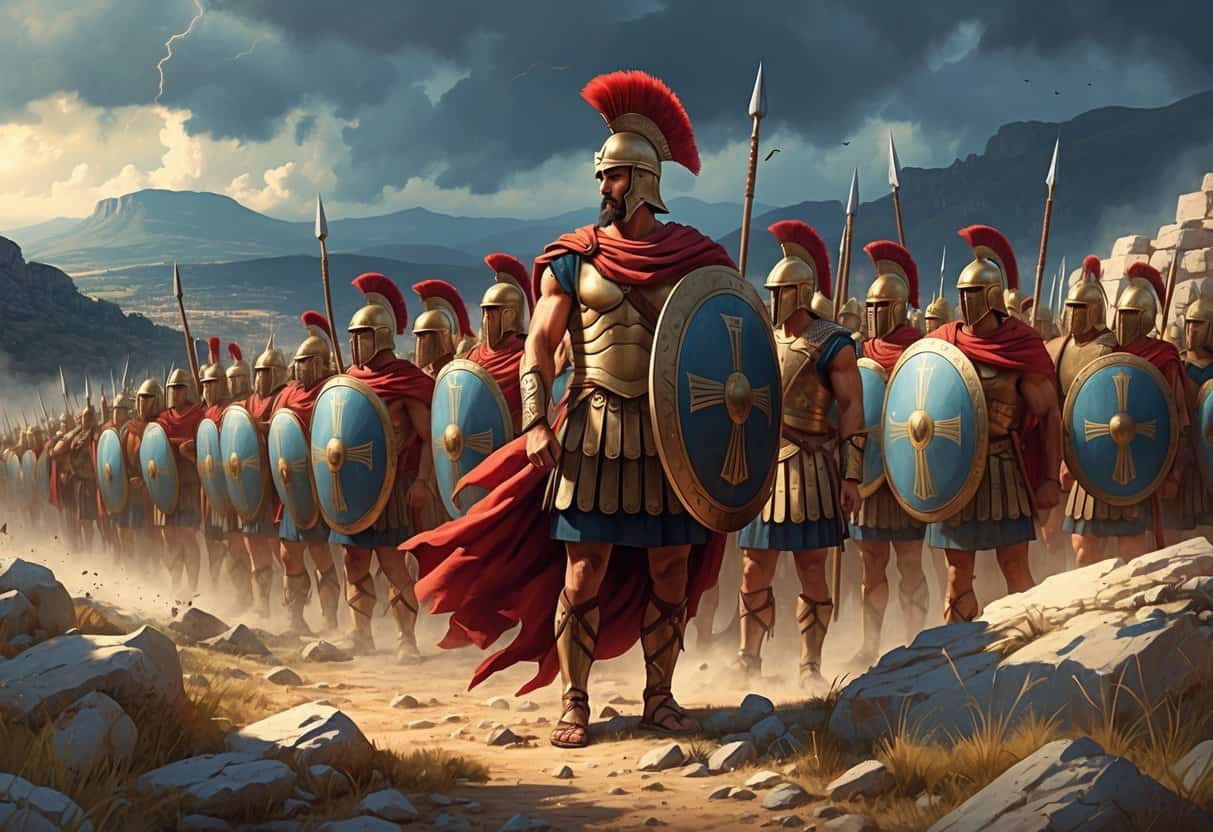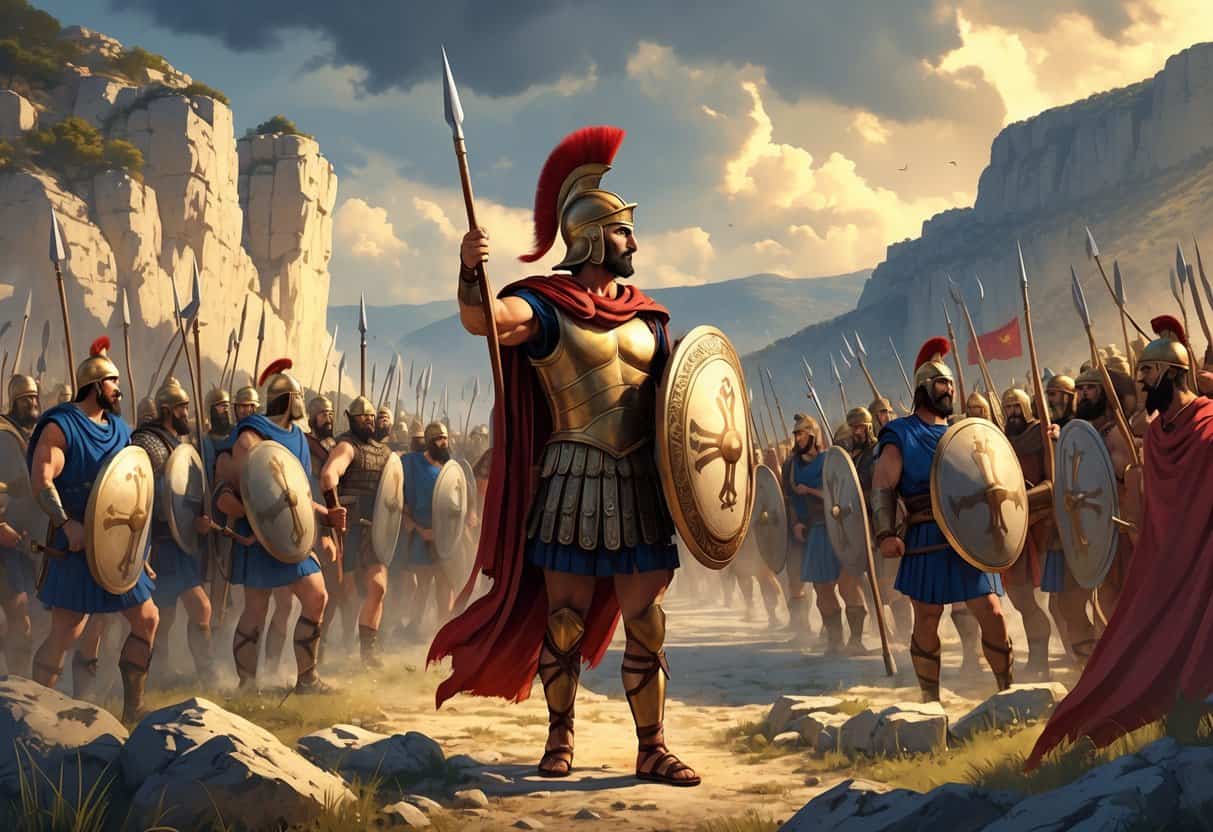Study Guide for Understanding Ancient Warfare and Leadership
The story of the 300 Spartans and their leader, King Leonidas, is one of the most famous in ancient history. These warriors stood against a massive Persian army at the Battle of Thermopylae.
Their bravery and sacrifice have made Leonidas and his soldiers symbols of courage and determination.

Leonidas wasn’t just a king—he was a skilled military leader from Sparta, one of the most powerful city-states in Ancient Greece. The battle that defined his legacy? That’s what we’re diving into here.
You’ll get a look at the events, the people, and why the 300 Spartans have stuck around in memory all these centuries later.
Key Takeaways
- Leonidas led a small Spartan force against a massive Persian army.
- The Battle of Thermopylae is a key event in ancient Greek history.
- The Spartans’ courage has inspired many long after their time.
Historical Context of Leonidas and Sparta

To get Leonidas’ story, you’ve got to know what made Sparta tick. Its society, politics, and the wild training that shaped its warriors—all of it set Sparta apart from the rest.
Spartan Society and Culture
Spartan society was built on discipline, military strength, and loyalty to the state. Social order was strict.
At the top were the Spartiates, full citizens who were professional soldiers. Below them, the Perioikoi—free but non-citizen residents who handled trade and crafts.
At the bottom were the Helots, enslaved people who worked the land. If you were Spartan, your daily life revolved around preparing for war.
Courage and teamwork were prized. Physical fitness wasn’t optional—it was a must.
Arts and philosophy? Not really Sparta’s thing. They left that to Athens.
Political Structure of Sparta
Sparta’s government was a mix—monarchy, oligarchy, and even a bit of democracy. There were two kings from separate royal families, including the Agiad line, leading the army and handling religious duties.
The kings didn’t rule alone, though. There was a council called the Gerousia—28 elders, plus the two kings, all over 60.
The Gerousia proposed laws and acted as a high court. Then you had the Apella, an assembly of male citizens who voted on major decisions.
Sparta’s system was all about balancing strong leadership with shared power among elites.
Role of the Agoge in Spartan Training
The Agoge was Sparta’s intense training program for boys, kicking off at age seven. You’d leave your family, join a group, and learn survival, combat, and discipline.
Physical toughness was everything. Food was scarce, living conditions rough—endurance was the goal.
Besides fighting, the Agoge drilled loyalty to Sparta and obedience to leaders. This training turned out soldiers like Leonidas—disciplined, skilled, and tough.
That’s a big part of why Sparta stayed a military powerhouse in ancient Greece.
Leonidas and the Battle of Thermopylae
Let’s get into King Leonidas’ rise, the threat from Persia, and what went down at Thermopylae. This story isn’t just about Spartans—it’s about their Greek allies too, all facing a force that seemed unstoppable.
Rise of Leonidas to Kingship
Leonidas became king of Sparta around 490 BCE. He was from the Agiad royal family, one of two Spartan royal lines.
As king, he followed the tough Spartan laws and valued strength and discipline. Growing up in Sparta meant training as a warrior from the start.
His leadership was shaped by that focus on toughness and loyalty. You can see it in how he got his soldiers ready for whatever came their way.
The Persian Threat and Xerxes
In 480 BCE, the Persian Empire, led by King Xerxes, invaded Greece. Xerxes wanted to expand his empire and get revenge for past defeats.
His army was huge—way bigger than any Greek force. The Persian army was a mix of soldiers from all over the empire.
Xerxes aimed to crush the Greek city-states, including Sparta. This threat pushed Greek leaders like Leonidas to come up with a plan, fast.
Strategy and Heroism at Thermopylae
Leonidas chose Thermopylae, a narrow mountain pass, as the battleground. The tight space helped the smaller Greek army hold off the massive Persian force.
Leonidas and his 300 Spartans, plus other Greek soldiers, held the pass for three days. They showed serious courage and skill, slowing Xerxes down.
The Spartans fought to protect their land, knowing survival was unlikely. That’s real heroism.
Role of Spartans and Allied Greek Forces
The 300 Spartans get the spotlight, but they weren’t alone. Other Greek forces—like Thespiae and Thebes—stood with them at Thermopylae.
The Spartans led the defense, drawing on their legendary training. Their sacrifice bought time for other Greeks to get ready for what came next.
This teamwork was a big deal in resisting the Persian empire and keeping Greek freedom alive.
| Key Points | Details |
|---|---|
| King Leonidas’ Leadership | Spartan king focused on strength and discipline |
| Persian Threat | Xerxes led a large invasion force |
| Battle Location | Thermopylae pass chosen for defense |
| Greek Forces | Spartans and allies united against Persia |
Key Figures and Historical Sources
Let’s meet the main figures connected to Leonidas and see how we know what happened at Thermopylae. These people shaped the story—and the sources keep it alive.
Family of Leonidas: Dorieus, Cleomenes, and Gorgo
Leonidas came from a family with serious military and political clout.
Dorieus was his brother, known for bold attempts to found new colonies outside Sparta. He died in battle, showing how Spartans chased glory beyond their borders.
Cleomenes, another relative, ruled Sparta before Leonidas. His reign was full of power struggles and reforms, shaping the world Leonidas inherited.
Gorgo, Leonidas’ wife, was a Spartan queen famous for her intelligence and strength. She played a political role during and after Leonidas’ reign.
Gorgo’s letters and advice are rare glimpses of a Spartan woman’s voice in history.
The Influence of Anaxandrides
Anaxandrides, Leonidas’ father, was a king before him. He belonged to the Agiad dynasty, one of Sparta’s two royal families.
His rule set the stage for Leonidas. The politics and marriages of Anaxandrides shaped Spartan alliances and who got the throne next.
Leonidas inherited the throne—and all its challenges—from Anaxandrides. That family line was everything in Spartan kingship.
Herodotus and the Documentation of Thermopylae
Herodotus is the main ancient historian who wrote about Thermopylae and Leonidas. He traveled, collected stories from Greeks and Persians, and tried to sort out fact from fiction.
Herodotus covers the strategies, the armies, and the Persian invasion under Xerxes. His work is a mix—history, legend, and rumor.
If you’re reading about the 300 Spartans, Herodotus’ Histories is the go-to source. Most of what we know comes from him.
Legacy of the 300 Spartans
The story of the 300 Spartans is proof that a small group can change history’s course. Their stand shaped later battles and became a symbol of courage and sacrifice.
Aftermath of Thermopylae and the Battle of Salamis
After Thermopylae, the Persian army pushed further into Greece. The Spartans’ sacrifice gave other Greek city-states time to get ready.
Soon after came the Battle of Salamis. The Greek navy, using clever tactics, defeated the much larger Persian fleet.
That victory stopped the Persian invasion and kept Greece free. The heroes at Thermopylae didn’t win the war alone, but their actions set up Greek success at Salamis.
Enduring Symbolism and Heroic Ideals
The 300 Spartans became a lasting symbol of bravery. Their choice to fight against impossible odds showed what it means to stand for your home and values.
Leonidas and his men are remembered as more than just warriors—they’re seen as examples of duty and honor. Their sacrifice is tied to loyalty and courage, even when the odds are hopeless.
Their story still inspires, popping up in art, literature, and speeches about what it means to be brave and free.
Modern Interpretations of Leonidas’ Legacy
These days, Leonidas and his 300 Spartans show up as both real people from history and larger-than-life symbols. Some folks point to their last stand as a striking example of leadership and sacrifice.
But there’s another side to it. Spartan society was tough, and only a few were chosen for battle, often putting duty before everything else—even life itself.
Choosing death over surrender? That’s still up for debate. The story brings up tricky questions about war, freedom, and what it really means to defend your home.
You’ll spot echoes of it in movies, books, and all kinds of conversations about what heroism and sacrifice actually are.